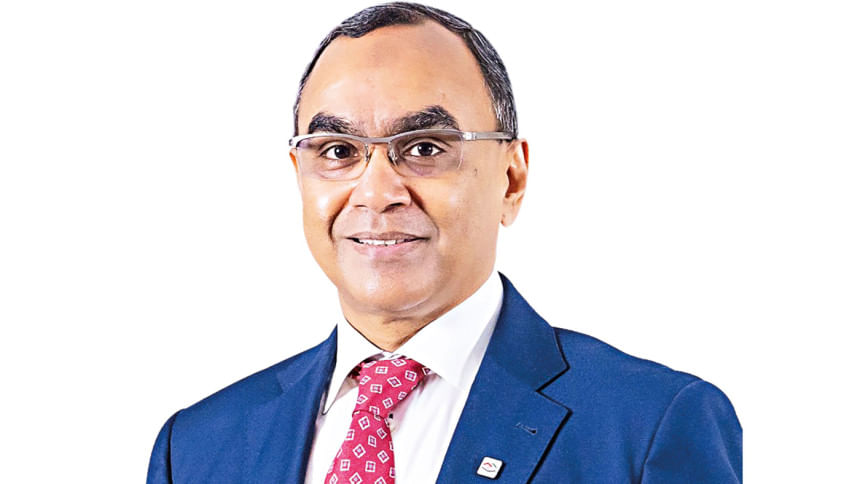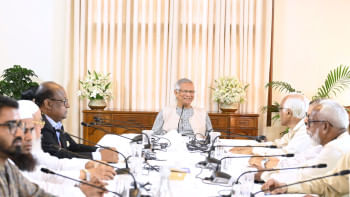Reducing footprint while expanding green finance

Syed Mahbubur Rahman
Managing Director & CEO, Mutual Trust Bank (MTB)
The Daily Star (TDS): How would you assess the current state of sustainable banking in Bangladesh?
Syed Mahbubur Rahman (SMR): Bangladesh has been profoundly affected by global human-induced climate change, despite contributing very little to the problem. The consequences are stark — frequent cyclones, tornadoes, floods, riverbank and coastal erosion, droughts, heatwaves, and prolonged summers. According to the Global Climate Risk Index 2021, Bangladesh is ranked as the seventh most disaster-prone country in the world, which highlights our extreme vulnerability.
In response, the banking sector has played a vital role. Banks now offer green finance loans, refinancing options, and dedicated funds aimed at mitigating climate change impacts and building resilience. The green banking policy has encouraged digitalisation, online branches, and solar-powered operations. Bangladesh Bank has also launched the Green Transformation Fund (GTF), initially for the textile, leather, and jute sectors, later expanded to include all export-oriented industries, facilitating greener export growth.
Overall, sustainable and green banking in Bangladesh is progressing well. Banks, including MTB, are embedding sustainability into their operations and portfolios. This is not just about compliance — it reflects our long-term commitment to environmental stewardship and a sustainable future for the nation.
TDS: What sustainable financing/refinancing schemes does your bank offer, particularly for SMEs, women entrepreneurs, or other environmentally responsible enterprises?
SMR: At MTB, our sustainable and green finance schemes are open to all institutions that meet the criteria, regardless of whether they are SMEs, corporates, or other enterprises. This inclusivity ensures that any organisation with sustainable initiatives can access financing.
For SMEs and corporates, we currently offer 94 green products across 14 sectors, including green buildings, effluent treatment plants (ETPs), renewable energy, and energy-efficient machinery. Beyond corporates, we also cater to retail clients with innovative solutions. For example, our paperless digital loan allows customers to apply directly from their mobile phones without paperwork or even visiting a branch — making sustainable finance more accessible than ever.
Additionally, we utilise Bangladesh Bank's refinance schemes and structure sustainability-linked loans to encourage enterprises to adopt environmentally responsible practices. In this way, we ensure that our financing directly contributes to sustainable growth across diverse sectors of the economy.
TDS: What initiatives has your bank undertaken to promote sustainable banking, and what measures have you implemented to reduce your own carbon footprint?
SMR: MTB's sustainability approach combines reducing our own footprint with expanding green financing. Internally, we have taken steps such as maintaining the air conditioning at 25°C, using sensor-based and energy-efficient lighting, encouraging daylight usage, and installing solar power at our head office, branches, and ATMs. An energy audit has been conducted to identify efficiency gaps, and Scope 1 and 2 GHG emissions are regularly monitored. Scope 3 financed emissions are now being assessed. Additionally, large-scale tree plantation programmes support natural carbon sequestration.
Externally, we have expanded our green portfolio across 14 priority sectors with 94 products, covering renewable energy, green buildings, effluent treatment plants, and energy-efficient machinery. These solutions ensure access for both SMEs and corporates.
We also focus on awareness and capacity building through employee training, client workshops, and environment-linked CSR initiatives. Together, these measures reduce our carbon impact and strengthen MTB's role in Bangladesh's transition to a greener economy.
TDS: What challenges has your bank encountered in adopting and promoting sustainable banking practices?
SMR: The journey has not been without challenges. One major hurdle is customer awareness — many clients, especially SMEs, are not fully familiar with the benefits and requirements of sustainable finance. This often requires banks like MTB to invest significant effort in one-to-one client engagement, capacity building, and technical support.
Another challenge is balancing profitability with sustainability. While green projects create long-term value, they often demand higher upfront investments and longer payback periods, which can discourage some businesses. Additionally, data gaps and the lack of robust ESG disclosure frameworks in Bangladesh make it difficult to track and report sustainability outcomes effectively.
Finally, broader economic and political uncertainties add further strain on the banking sector. However, initiatives such as Bangladesh Bank's sustainability rating demonstrate that banks can remain compliant with regulations and continue building trust with customers through sustainable practices.

 For all latest news, follow The Daily Star's Google News channel.
For all latest news, follow The Daily Star's Google News channel. 



Comments